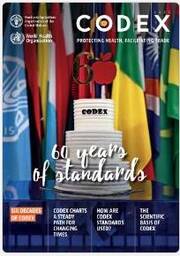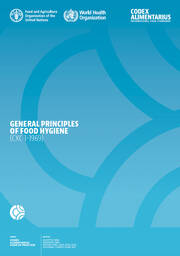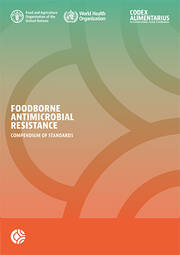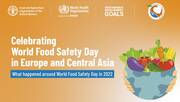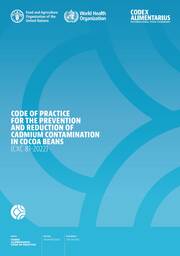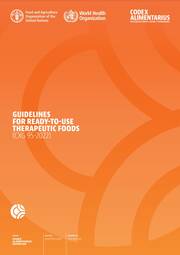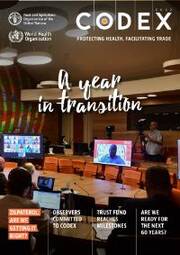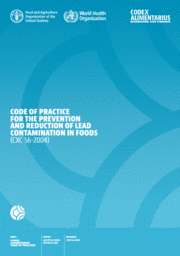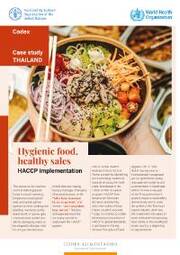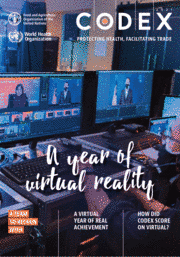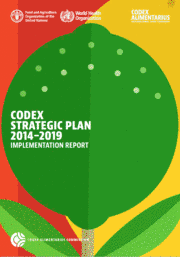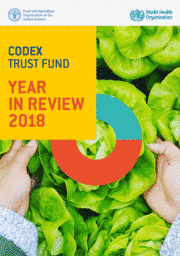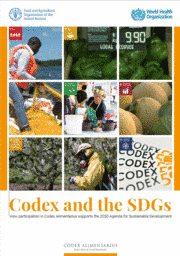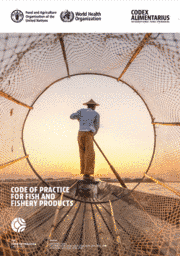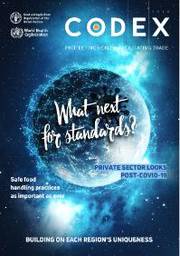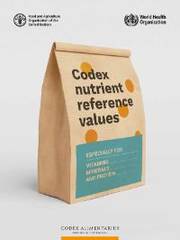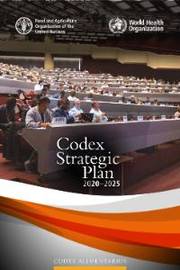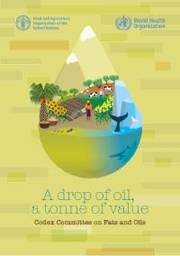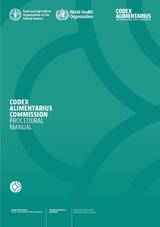Main Releases
The Codex Alimentarius Commission marks its 60th anniversary in 2023. This seventh edition of the CODEX magazine looks back at origins and looks forward to what the future may bring for the international food standard setting. Those involved in Codex, whether they be current or former Commission Chairs, Secretaries, Members or Observers, experts or host secretariats, have contributed to this celebration of Codex achievements. This publication also summarizes the work of the technical and regional committees that have met since the 45th Commission in 2022, bringing new, amended and revised texts for adoption in November 2023. It captures six decades and a year in the life of the Commission and the Codex Secretariat – working to protect health and facilitate trade.
Year: 2023 - Language: English
The Codex Secretariat conducts a yearly survey for all Codex Members to measure the use and impact of Codex texts. Mandated to monitor this topic through the Codex Strategic Plan 2020–2025, in 2021, the Secretariat, in collaboration with FAO and WHO evaluation offices, began developing a mechanism to explore issues such as accessibility, relevance and credibility concerning Codex standards. The 2022 survey served as the pilot for this new endeavour.
The report of the Codex Survey 2022 presents the results of the first pilot survey on the use and impact of Codex texts. The survey focused on the following Codex texts: General Standard for Contaminants and Toxins in Food and Feed, General Principles of Food Hygiene, General Standard for the Labelling of Pre-packaged Foods, and General Principles for the Addition of Essential Nutrients to Foods.
It provides information on the outreach, relevance, recognition and use of Codex texts, and ultimately on their impact. The report highlights barriers to the uptake of Codex texts by Members and makes a series of recommendations.
Year: 2023 - Language: English, French, Spanish, Chinese, Russian.
This code of practice has been published in the new format with refreshed design and a DOI (digital object identifier) to monitor downloads and citations.
The General Principles of Food Hygiene is the fundamental Codex document describing the necessary food hygiene measures and food safety controls.
This new revision sees information on the hazard analysis and critical control point (HACCP) system move from an annex into the main body of the document. The update also includes modern concepts not addressed in older versions, including the role of Good Hygiene Practices (GHPs) that require additional attention because they have a greater impact on food safety.
Year: 2023 - Language: English
Antimicrobial resistance (AMR) is a serious global health threat and a food safety issue of primary concern. Governments and international organizations have recognized that the issue has to be approached in a multidisciplinary manner, addressing animal, plant and human health as well as the environment under the One Health approach.
This publication brings together the three Codex texts, two guidelines and a code of practice, that will support governments in designing and running a successful strategy to tackle foodborne AMR.
Year: 2023 - Language: English, French, Spanish, Russian.
This report describes initiatives that were organized by countries in the region for World Food Safety Day in 2022. With over 20 colourful examples from Europe and Central Asia Region, the report also served as a motivator for WFSD in 2023.
Year: 2023 - Language: English
This code of practice has been published in the new format with refreshed design and a DOI (digital object identifier) to monitor downloads and citations.
Cadmium is a heavy metal that predominantly enters the environment through anthropogenic activities such as processing ores, burning fuels, contamination with industrial waste, livestock manure, and use of phosphate fertilizers.
This code of practice provides guidance on recommended practices to prevent and reduce cadmium contamination in cocoa beans before planting, for new or existing cocoa tree plantations and during the production stage through the harvest and post-harvest phases.
Year: 2023 - Language: English
This guideline is another new-look Codex text, which all now include a refreshed design and a DOI (digital object identifier) to monitor downloads and citations.
This publication provides guidance on technical and nutritional aspects of the production of ready-to-use therapeutic foods (RUTF). The provisions of these guidelines apply to RUTF for children aged from 6 to 59 months with severe acute malnutrition (SAM) who need efficacious and timely intervention including safe, palatable foods with a high-energy content and adequate amounts of vitamins, minerals and other nutrients within an appropriately designed programme that promotes continuation of breastfeeding, appropriate transition to nutritious family food and psycho-social support for recovery.
Year: 2023 - Language: English
The CODEX magazine reviews a year in the life of the international food safety standard setting body the Codex Alimentarius Commission. With testimony from the experts who attend technical meetings to set standards and the countries that host those committees, CODEX in 2022 tells the story of another year where operations have been virtual.
Contributions from the parent organizations FAO and WHO combine with insight from Observer organizations and those who operate from within the Codex Secretariat to ensure that once again the Commission will be adopting over 20 new texts this year to ensure food is safe and can be traded fairly.
Year: 2022 - Language: English
This code of practice is a pilot for the update of all Codex texts planned for 2023. New features include a refreshed design and a DOI (digital object identifier) to monitor downloads and citations of Codex texts.
Lead exposure can occur through food and water and lead contamination of food arises from numerous sources, including air, soil and water as well as from food processing, food handling, and food packaging. This code of practice indicates good agricultural and manufacturing practices to minimize lead contamination of foods.
Year: 2022 - Language: English
This case study demonstrates the impact that adoption of science-based food standards can have. When the Thai government adopted into law the Codex General Principles of Food Hygiene (CXC 1-1969), which includes guidelines on the application of the Hygiene Analysis and Critical Control Points system (HACCP) as one of its annexes, it made HACCP non-mandatory, but highly recommended. With support from FAO, the government ensured HACCP training across private companies – especially small businesses, government departments and academia.
Now, after 25 years of work promoting HACCP, the country is reaping the rewards in improved food safety at home and robust and competitive food exports.
Year: 2022 - Language: English
This issue of CODEX tells the story, committee by committee, of the commitment by global experts, host governments and the Codex family of Members and Observer organizations to ensure that the 44th Codex Alimentarius Commission would take place and have over 30 texts to adopt, protecting health and facilitating trade.
In a year of virtual reality it has been the ground-breaking work of all those involved to take meetings online that has ensured continuity throughout the pandemic.
Year: 2021 - Language: English
In 2013 the Codex Alimentarius Commission (CAC) approved its most ambitious plan to date: the Codex Strategic Plan 2014-2019. Structured around four goals, the plan aimed to guide Codex work towards more effective communication and efficient practices that would promote robust, inclusive, transparent and collaborative food standards setting.
This implementation report examines the achievements of the Strategic Plan 2014-2019. It is divided into sections that focus on the plan’s four goals and provides a summary of successes achieved and identifies the challenges that arose.
Year: 2021 - Language: English
The Codex Trust Fund (CTF) supports developing and transition economy countries to participate fully and effectively in Codex.
Exploring 12 country and one group project from around the globe, this publication tells the story of each country’s achievements and successes, as well as the challenges they faced in designing, planning and delivering projects under the Trust Fund.
It also serves as a valuable resource, rich with lessons learned for those countries currently embarking on CTF projects or planning to do so in the future.
Year: 2020 - Language: English
This publication developed by the Codex Trust Fund in collaboration with the Codex Secretariat describes how participation in Codex Alimentarius supports the 2030 Agenda for Sustainable Development
With stories and reports focussing on six SDGs in different countries, readers learn how Codex work supports countries to achieve these particular development goals, which are interconnected with other SDGs and the 2030 Agenda generally.
Codex and the SDGs also highlights how the Codex Trust Fund supports developing and transition economy countries to build food safety capacity, which helps equip them to pursue the SDGs more successfully.
Year: 2020 - Language: English
This updated version of the Code of Practice for Fish and Fishery Products delivers key technical guidance on the harvesting, processing, transport and sale of fish and fishery products and is an essential reference point for both small and large-scale operators.
New guidance developed in the Codex Committee on Food Hygiene is now included in the code, introducing valuable additional information and technical direction on how to minimize the risk of histamine build-up in fish and fishery products at key steps in the food chain from harvesting to processing.
Year: 2020 - Languages: Arabic, Chinese, English, French, Russian and Spanish
Each year this annual report, in a captivating magazine format, records the work of the Codex Alimentarius from one Commission to the next.
Before the COVID-19 pandemic brought a halt to international travel and physical meetings in March 2020, some of the technical committees and all six FAO/WHO Coordinating Committees did meet as planned.
With a special focus on the Codex regions including contributions from Member Countries, the Codex parent organizations and some of the global experts who work with Codex, this 4th edition of the magazine reports on local, regional and global issues effecting food safety and fair practices in food trade.
Year: 2020 - Languages: Arabic, Chinese, English, French, Russian and Spanish
The second UN World Food Safety Day fell amid the extraordinary global moment of the COVID-19 pandemic. It was a day and, often a week or more, of ‘masks, microbes and microphones’ that saw initiatives – organized by individuals, families, communities, schools, businesses and government offices – reshaped for a ‘new normal’ that looks set to affect food safety and food systems for the foreseeable future. In this overview of the global celebrations, we take a glimpse at the webinars, videos, press conferences, editorials, contests, social media posts, campaign messages and more that involved millions of people across the world in May and June 2020.
Year: 2020 - Languages: English, French, Spanish, Arabic, Chinese and Russian
This publication explains how Codex and the Committee for Nutrition and Foods for Special Dietary Uses worked over several years to develop the Codex nutrient reference values for protein, 13 vitamins and 6 minerals in the Codex guidelines for nutrition labelling. Nutrient reference values (NRVs) are a set of values used in nutrition labelling derived from authoritative recommendations for daily nutrient intake.
Drawing from primary evidence from several countries, the publication will play a role in informing the general population about healthy eating for the next 10-20 years and forms the basis for establishing a suite of required NRVs for more specific population groups, the first of which are older infants and young children.
Year: 2019 - Language: English
The 2020-2025 Strategic Plan presents the mission, vision, goals, objectives and measurable indicators for the Codex Alimentarius Commission. It underpins the high priority that continues to be placed on food safety and quality by FAO and WHO and guides the Commission in carrying out its responsibilities and unique mandate to protect consumer health and ensure fair practices in the food trade. The Strategic Plan informs Members, inter-governmental and international non-governmental organizations, and other stakeholders of how the Commission intends to fulfil its mandate and to meet the needs, including emerging issues, and expectations of its Members during the period 2020-2025.
Year: 2019 - Language: English, French, Spanish, Russian and Chinese
2019 has been the year of food safety with The First FAO / WHO / AU International Food Safety Conference in Addis Ababa and the WTO International Forum on Food Safety and Trade in Geneva shining the global spotlight on issues that will affect global food production and supply systems, consumers, industry and the planet itself. The Codex Alimentarius Commission is where the world comes together to set international food safety and quality standards to protect consumer helath and facilitate intenrational trade.
This publication reports on the Codex year and is produced in conjunction with the 42nd Codex Alimentarius Commission held in Geneva 8-12 July 2019.
Year: 2019 - Language: English
Matters of food authenticity are less likely to create problems for public health but they can and do create great damage in the market, leading to breakdowns in consumer confidence and unfair competition as honest traders are unable to match the discounted prices of their fraudulent rivals.
The Codex Committee on Fats and Oils (CCFO) was established in 1964 to elaborate worldwide standards for fats and oils of animal, vegetable and marine origin including margarine and olive oil.
This publication explores how CCFO operates and the role Malaysia has played since taking over the committee from the UK in 2009. With contributions from producing nations, traders, members and observers, the reader will glimpse what goes on in an international standard setting body to ensure safe food and a level playing field for trade.
Year: 2019 - Language: English
In 1964, nine Codex Alimentarius Commission Member countries and a number of Observer organizations gathered in Washington DC, United States of America to begin building consensus on how to produce food hygienically and, where feasible, set limits for microbial counts in foods. Thanks to the visionary approach of Codex in those early years, knowledge about how to safely prepare and handle food was used to develop standards, providing tools for both national regulatory authorities and the food industry to systematically improve food hygiene. The leaps and bounds made over five decades mean that food can now be safely produced, processed and distributed in greater volumes and over greater distances than ever before.
Year: 2019 - Language: English, French, Spanish
The Handbook provides guidance to national officials nominated to serve as chairpersons of subsidiary bodies of the Codex Alimentarius Commission — grouping together in one handy place a range of institutional memory, good practices, rules and useful tools for use as a reference by chairpersons as they prepare for and discharge their duties. The number of committees in the Codex system and the way in which they are chaired had demonstrated the need for such an information product. In the form of a Handbook, it serves as a legacy publication, enshrining as a single resource more than a decade of practical knowledge and experience of senior Secretariat officials and the community of experienced Codex chairpersons.
The Handbook will contribute to: ensuring the effective and equitable participation of Member State officials in Codex work (capacity-development); enhancing communication with stakeholders (communication); and promoting transparency, neutrality and an open, rules-based approach in the conduct of Codex work.
The Handbook is structured to serve as a direct and useful guide for its primary community of users — Codex committee chairpersons — and works hand-in-hand with other resources, guiding chairpersons to participate and build a living community of practice through multiple online resources, such as the Codex Online Commenting System and Codex Chairpersons’ Platform.
Year: 2018 - Language: English
For more than five decades Codex texts have contributed immensely to the safety and quality of the food we eat. The Codex Alimentarius forms a global rule book that everyone in the food chain can follow, and it is at the same time a lifeline to those countries still working to strengthen their own national food safety control systems.
This 5th edition of Understanding Codex will allow readers to have an informed view of the Codex Alimentarius Commission, how it works and what it has achieved. Interested readers to will quickly grasp the structure of the Codex system and gain an insight into the specialized technical committees and the detailed procedures and processes of Codex.
Year: 2018 - Language: English, French, Spanish, Chinese and Russian
This publication showcases the steps the Codex Alimentarius has taken from July 2017 (CAC40) to July 2018 (CAC41) on the road to safe and quality food for everyone.
Over the course of the year, Codex committees met to discuss updates to the international food standards, guidelines and codes of practice. The “food code’s” governing body, known as the Codex Alimentarius Commission (CAC), makes decisions on the committees’ proposals during its annual meeting in July.
Through an array of magazine-style articles, “Codex" shares the viewpoints and contributions of the diverse partnership, which includes 188 Member Countries and the European Union as well as over 200 Observers.
Year: 2018 - Language: English, French, Spanish, Chinese and Russian
In a new report, Trade and Food Standards, the UN Food and Agriculture Organization (FAO) and the World Trade Organization (WTO) offer a concise explanation of how international food standards are set and applied. The harmonization of standards aims to bolster public health, reduce the burden of compliance on producers and minimize the risk of costly disruptions to trade.
Year: 2017 - Language: English
This publication showcases the steps the Codex Alimentarius has taken from July 2016 (CAC39) to July 2017 (CAC40) on the road to safe and quality food for everyone. Over the course of the year, the 12 technical and 6 regional committees met to discuss updates to the international food standards, guidelines and codes of practice. The “food code’s” governing body, known as the Codex Alimentarius Commission (CAC), makes decisions on the committees’ proposals during its annual meeting in July. Through an array of magazine-style articles, “The Science of Food Standards - The road from Codex Alimentarius Commission 39 to 40” shares the viewpoints and contributions of the diverse partnership, which includes 187 Member Countries and the European Union as well as over 200 Observers.
Year: 2017 - Language: English
The Codex Alimentarius Commission envisages a world afforded the highest attainable levels of consumer protection including food safety and quality. To this end, the Commission will develop internationally agreed standards and related texts for use in domestic regulation and international trade in food that are based on scientific principles and fulfil the objectives of consumer health protection and fair practices in food trade.
Year: 2014 - Language: English
The Procedural Manual of the Codex Alimentarius Commission sets out the basic Rules of Procedure, procedures for the elaboration of Codex standards and related texts, basic definitions and guidelines for the operation of Codex committees.
This edition incorporates the new layout of Codex texts. It also amends the section on commodity standards dealing with non-retail containers; introduces text on working by correspondence and presents a new annex on extrapolation of maximum residue limits of veterinary drugs.



